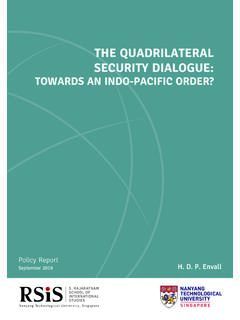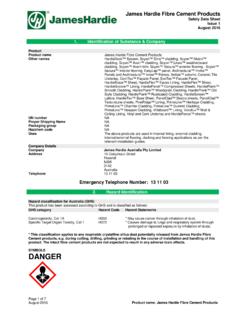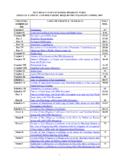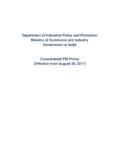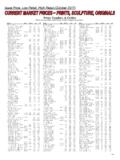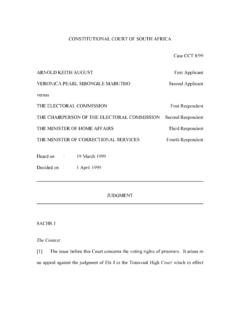Transcription of Counter Terrorist Trends and Analysis
1 1 Volume 8, issue 8 | august 2016 Counter Terrorist Trends and Analysis The Islamic State Wilayats & Global Expansion Rohan Gunaratna & Natasha Hornell-Scott A JOURNAL OF THE INTERNATIONAL CENTRE FOR POLITICAL VIOLENCE AND TERRORISM RESEARCH ISSN 2382-6444 | Volume 8, issue 8 | august 2016 B u i l d i n g a G l o b a l N e t w o r k f o r S e c u r i t y Counter Terrorist Trends and Analysis A Comparative Analysis of Islamic State and Al Qaeda in Yemen Mohammed Sinan Siyech An Overview of the Syrian Conflict Syed Huzaifah Bin Othman Alkaff & NurulHuda Binte Yussof Terrorist Attacks.
2 The Politics of Claiming Responsibility Nodirbek Soliev & Mohammed Sinan Siyech 2 Volume 8, issue 8 | august 2016 Counter Terrorist Trends and Analysis W The Middle East continues to be the centre of gravity for conflict and terrorism. While airstrikes from the US-led coalition and Russia have led to significant attrition in the so-called Islamic State (IS) s infrastructure and hold on territories, continuing IS attacks in the Middle East underscore the insurmountable challenges facing countries in the region. Some of the more recent attacks conducted by IS include the suicide bombing on 21 august 2016 which killed 51 people and injured 69 others in the Turkish city of Gaziantep, as well as a car bomb attack targeting police in eastern Turkey by the Kurdistan Workers' Party (PKK) that killed five people and injured over 200.
3 In addition, IS has continued to stifle opposition and dissent through executions within its territories in Iraq and Syria. In Yemen, Al Qaeda in the Arabian Peninsula (AQAP) and IS capitalised on the on-going civil war and conflict between the government, backed by the Saudi-led coalition, and the Houthi-led opposition. AQAP even managed to seize and control territory when it stormed the port city of Mukalla, which also gave the Terrorist group access to the town s financial resources. While some analysts have written off Al Qaeda in the global jihad stage, AQAP s successes in Yemen have effectively established Al Qaeda as a continuing formidable security threat.
4 Although the newly rebranded Jabhat Fateh al-Sham (formerly known as Jabhat al-Nusra) has divorced itself from Al Qaeda and its emir Ayman al-Zawahiri, it nevertheless remains dangerous and may continue to serve as Al Qaeda s proxy in the Syrian conflict. Despite experiencing serious territorial losses on the battleground, IS has its eye on establishing its foothold in other parts of the world where governance is weak. Rohan Gunaratna and Natasha Hornell-Scott cast a spotlight on IS ambitions to establish its caliphate in places beyond the Middle East through wilayats, otherwise known as IS satellite provinces.
5 Five years into the Syrian conflict, Syria s opposition groups remain in disunity. This has presented Terrorist groups such as Jabhat Fateh al-Sham and IS with an opportunity to infiltrate the various groups in the country, to further their vision of the Islamic caliphate. Syed Huzaifah Bin Othman Alkaff and NurulHuda Binte Yussof explain how the competition between anti-Assad opposition groups and the infiltration of Terrorist groups into the anti-Assad opposition front portends serious security implications for the region as a whole. Although IS has made inroads into Yemen, the group has not succeeded in establishing a foothold there, as it has done in Syria, Iraq and Libya.
6 Mohammed Sinan Siyech examines the reasons behind why the IS wilayat (governorate) in Yemen has been unable to make major strides and offers a case study of the conquests which AQAP has been making in Yemen. Nodirbek Soliev and Mohammed Sinan Siyech argue that the decision by a group to claim responsibility for an attack is a rational and calculated move, and that the politics of claiming an attack is by nature strategic. While it benefits IS to take responsibility for the Orlando shooting and Nice attack, IS refrained from doing the same in the case of the attacks in Turkey and Saudi Arabia due to fears that authorities might intensify their attacks on the group in Iraq and Syria and move in to arrest their members and eliminate their network of cells and disrupt their operations in Turkey and Saudi Arabia.
7 Editorial Note The Middle East The views expressed in the articles are those of the authors and not of ICPVTR, RSIS, NTU or the organisations to which the authors are affiliated. Articles may not be reproduced without prior permission. Please contact the editors for more information at The editorial team also welcomes any feedback or comments. Dr. Rohan Gunaratna Professor of Security Studies Head of International Centre for Political Violence and Terrorism Research Dr. John Harrison Associate Editor Journal of Transportation Security Dr.
8 Kumar Ramakrishna Associate Professor Head of Policy Studies & Coordinator of National Security Studies Programme Editor-in-Chief Associate Editors Design and Layout Stefanie Kam Sara Mahmood Shahzeb Ali Rathore Okkie Tanupradja Dr. Fernando Reinares Director, Program on Global Terrorism, Elcano Royal Institute Professor of Security Studies, Universidad Rey Juan Carlos, Madrid, Spain Dr. Stephen Sloan Professor Emeritus, The University of Oklahoma Lawrence J. Chastang, Distinguished Professor of Terrorism Studies, The University of Central Florida ADVISORY BOARD 3 Volume 8, issue 8 | august 2016 Counter Terrorist Trends and Analysis Wilayats are territorial claims made by the so-called Islamic State (IS) to further its ambitions of establishing a global caliphate.
9 They are located in weak areas of a country where the government lacks significant control and influence. As of June 2016, there are twelve internal wilayats located in Syria and eleven in Iraq, and external wilayats in nine countries. However, IS has plans to expand further, which means that countering the influence and spread of wilayats needs to be prioritised in order to curb IS global expansion. Introduction The overarching aim of the Islamic State (IS) is to build a global Islamic caliphate and to impose its own version of Islamic law from Spain to Africa (Maghreb, Sahel and sub-region), the Middle East, the Caucasus, Central, South and Southeast Asia and Xinjiang in China.
10 To achieve this goal and live up to its slogan of remaining and expanding, IS strategy is to grow from its epicentre in Iraq and Syria into other regions, linking the caliphate with their provinces, thereby expanding its influence globally. IS-associated threat groups, networks and individuals are influenced by several factors which include its sophisticated media campaign, declaration of the caliphate and control over territory. The group conducts violent attacks against transgressors and disbelievers to enforce Abu Bakr al Baghdadi s version of Islamic law, strengthening its appeal in the eyes of other extremist groups worldwide.
